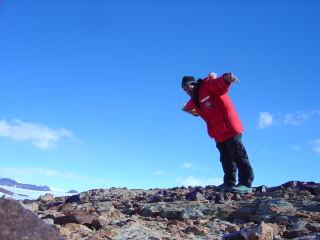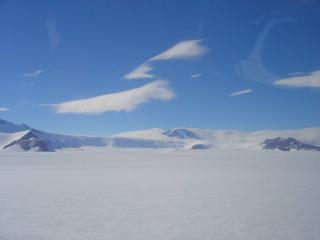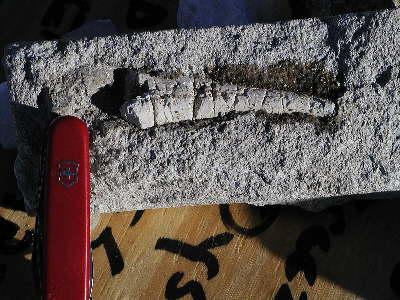11 December, 2003
It's funny how the weather works.
We awoke to a beautiful day. The sun was out of course and there was a slight north wind. The thermometer in my tent registered 50 degrees! It is amazing how warm it can get in the tent even when the outside temperature is so low. As long as the wind is down and the sun is above the horizon by 20 degrees the temperature can really climb in the tent.
As I walked over to the cook tent I looked toward our mountain, Mt. Kirkpatrick, and saw a cloudbank hanging over the area. The problem with clouds on mountains in Antarctica, are they usually mean wind (orographic lifting), and these clouds were lenticular (lens shaped) which means high velocity winds. If you looked carefully at the mountain, you would see that that cloud was part cloud and part blowing snow, this meant that the mission to Kirkpatrick would be scrubbed. Dr. Hammer quickly changed our allotted flight time to take us to the Gordon Valley where he had been before and he knew that we could find some fossil bone. There are some mid Triassic beds that have a lot of bones in clasts so we decided to see what we could do there.
We took off around 9 AM and as soon as we were airborne and climbed to 200 feet we were hit with a pretty big head wind. Normally when we fly to Kirkpatrick, we go 3 at a time because our work zone is near the operational ceiling of the helicopter however, since we were flying on the glacier at about 6,000 feet, we were able to take 6 passengers. This still made for a wild ride as we were buffeted and twisted enroot to the Gordon Glacier because of the up and down drafts coming from the surrounding mountains.
As we approached the landing zone, pilot had to deal with swirling winds and boulders that are scattered all over, so landing the 212 was difficult, and it took several attempts to put the bird down. As soon as we got off the aircraft, we struggled against 40-knot winds to clear our gear from the cargo bay and get a safe distance from the aircraft. As soon as the helicopter departed the area, we took our gear and dropped below a sedimentary structure to get out of the wind, there we regrouped and made our day's plan.
The sediments in the Gordon Valley are from the mid Triassic, and Dr. Hammer had been here before collecting Synapsids so we knew that we would find fossil remains. We fanned out and started searching, when you found bones you would build a stone mound to mark the place then continue on. Next, the sites would be visited by Drs. Hammer and Curie who would determine which were best to remove in the time we would be there. The wind continued to build, and the sun stayed behind a cloud so with the temperatures around 10 degrees F. it was not the most pleasant place to work. I too a walk to the windward side of the plateau and leaned over the ledge (only four feet from the ledge below) and I was able to lean into it and not fall over, it was almost like flying.
With conditions worsening we called for a ride back to camp. We collected several bones, the best being an ulna from a synapsid (type of reptile) that will probably date back around 220 million years. But we did not accomplish a lot today mostly because we were not knocking off our primary goal, which is getting the rest of Cryolophosaurus and exploring other possible fossil bearing strata. As we flew back, we looked towards Mt. Kirkpatrick and we saw it was still engulfed in clouds and swirling winds and at this writing it has not lifted. We can only hope for a better tomorrow and with that, I will close this entry and get some sleep to get ready for whatever tomorrow may bring.
Cheers,
Andy

Leaning into the wind!

Mt. Kirkpatrick in the clouds with lenticular clouds above.

Ulna of an synapsid found in the Gordon Valley, Antarctica.
Contact the TEA in the field at
.
If you cannot connect through your browser, copy the
TEA's e-mail address in the "To:" line of
your favorite e-mail package.
|
